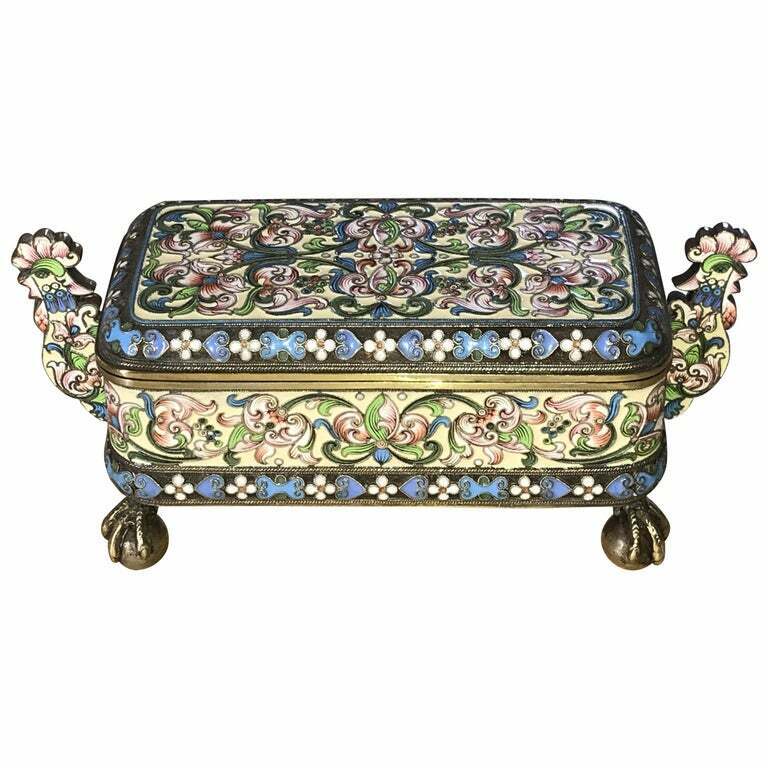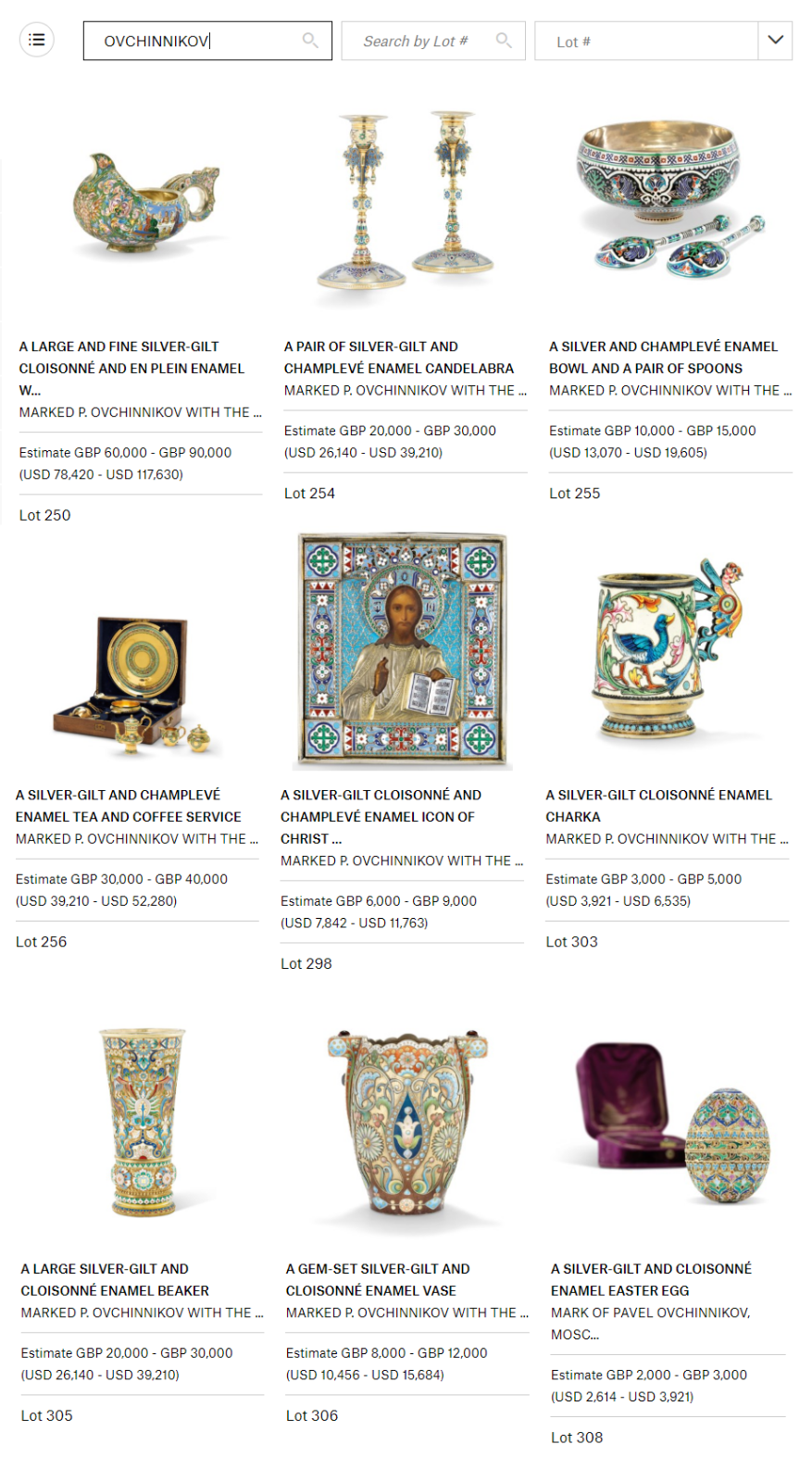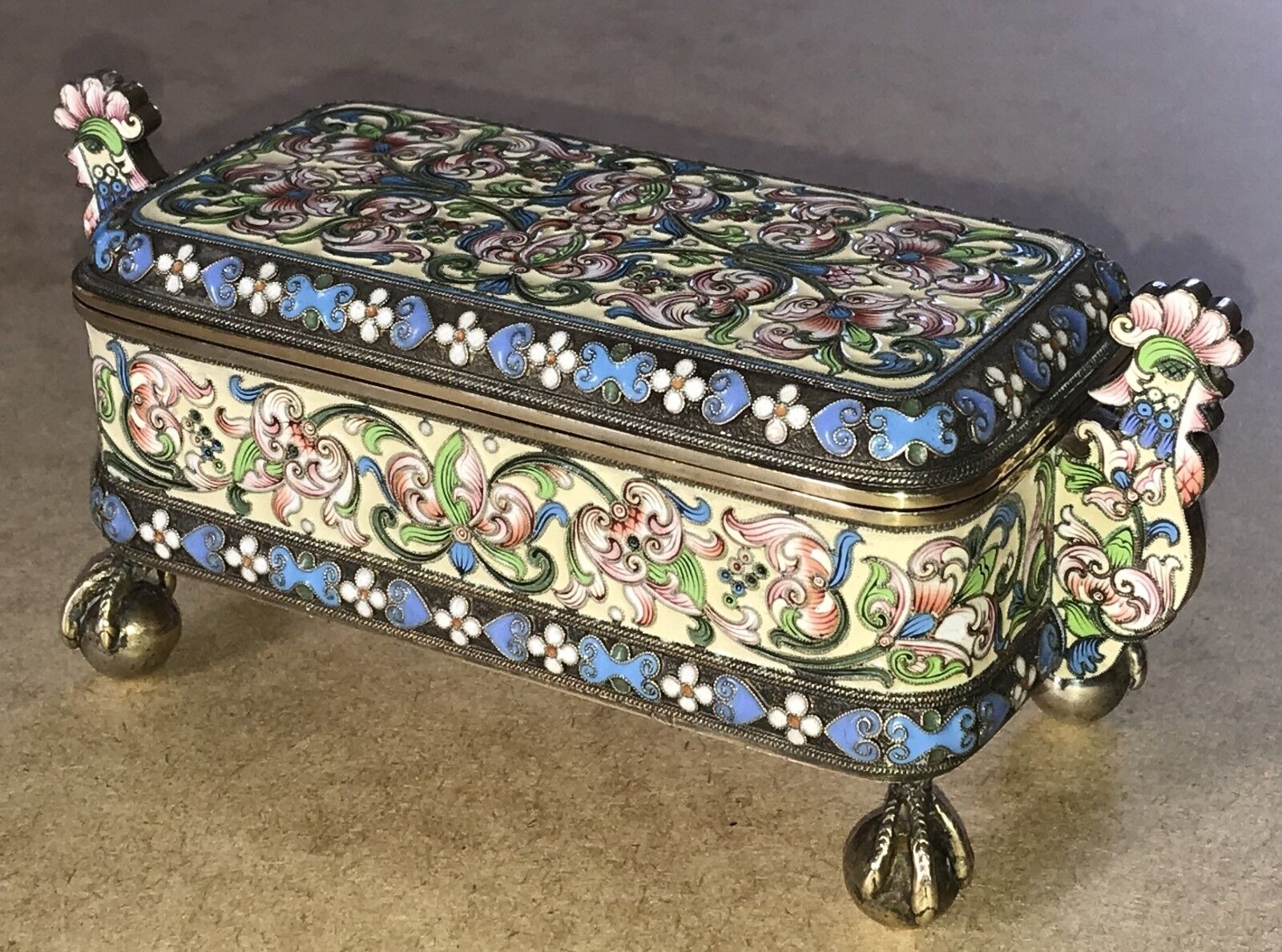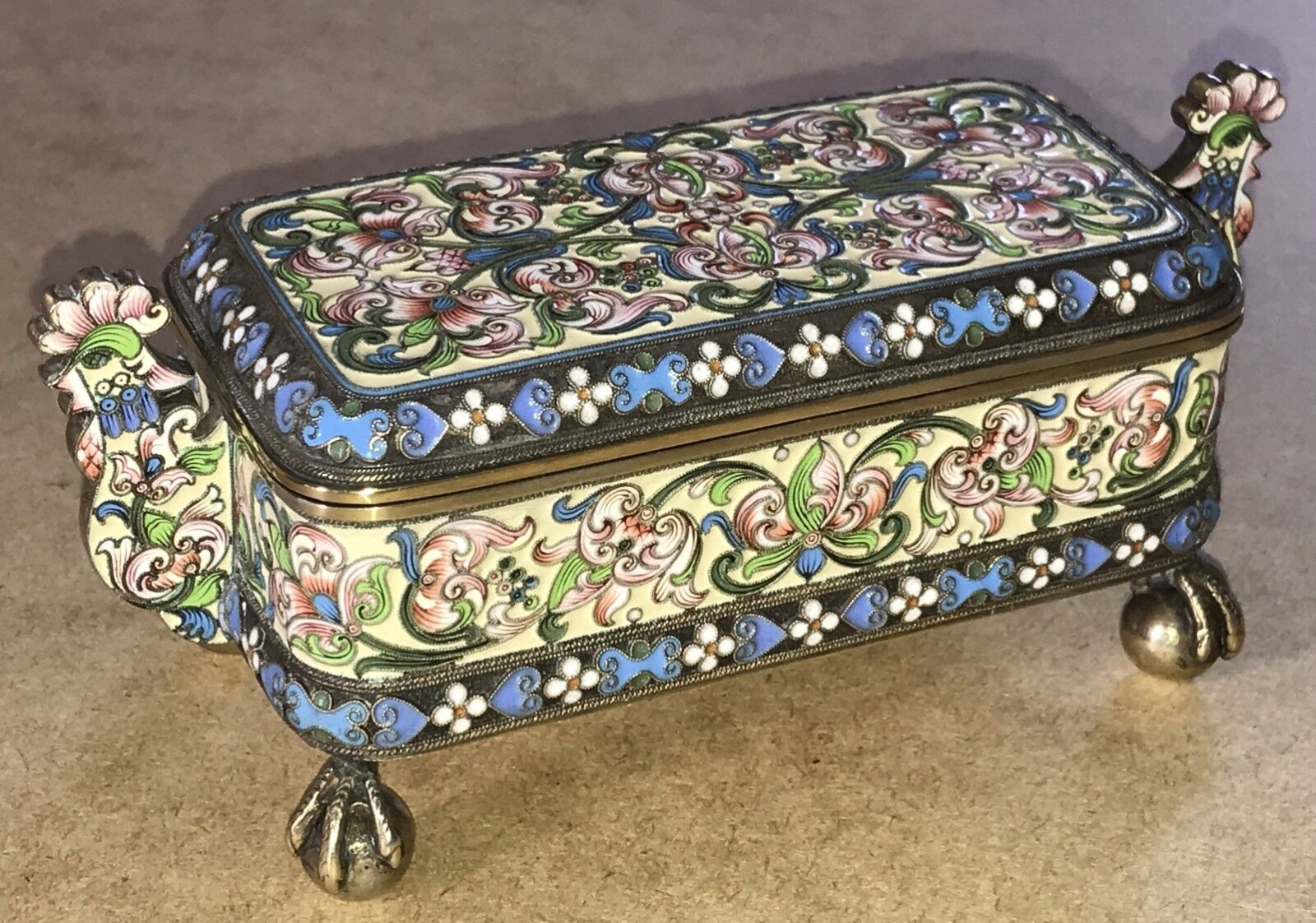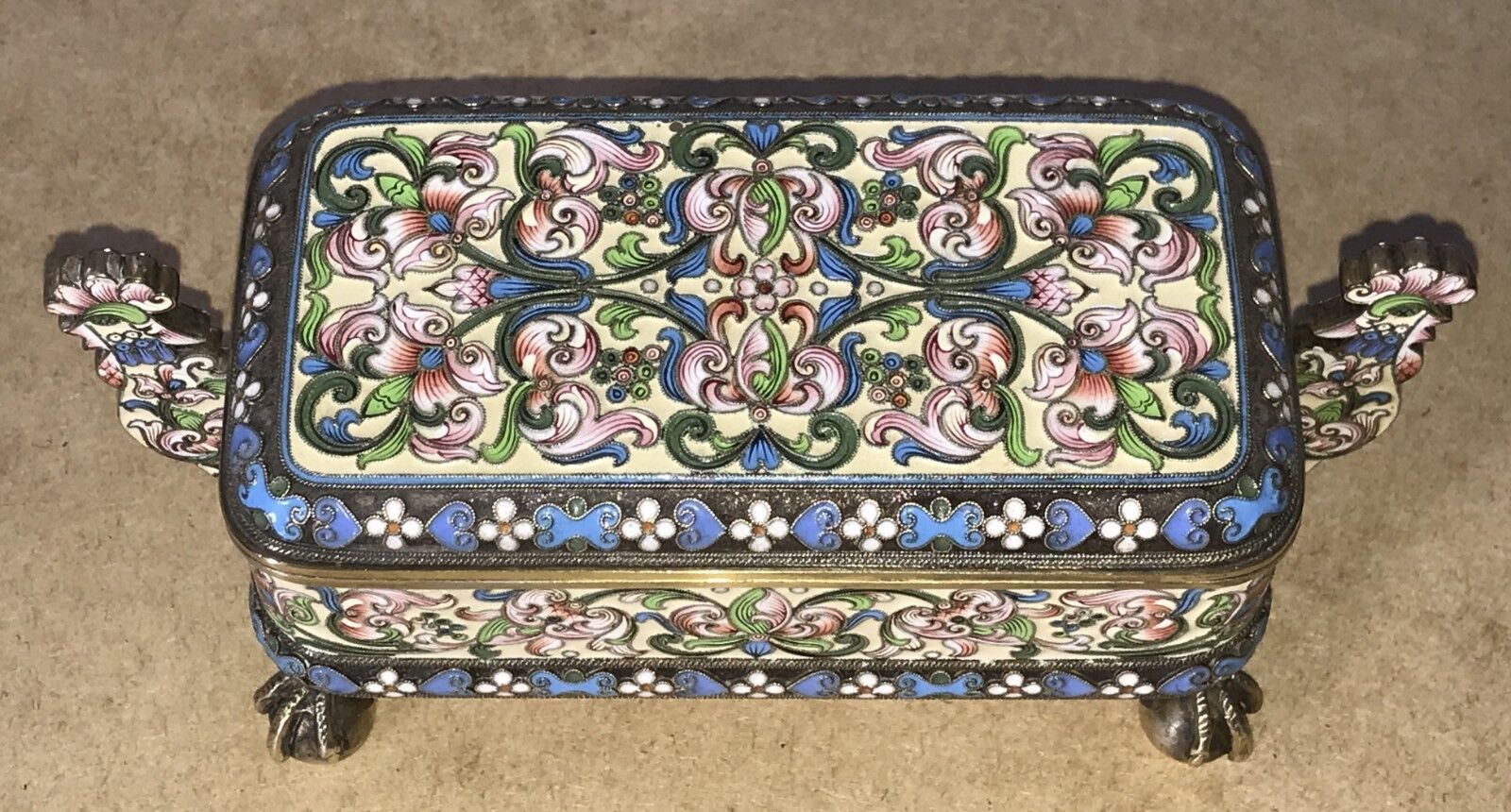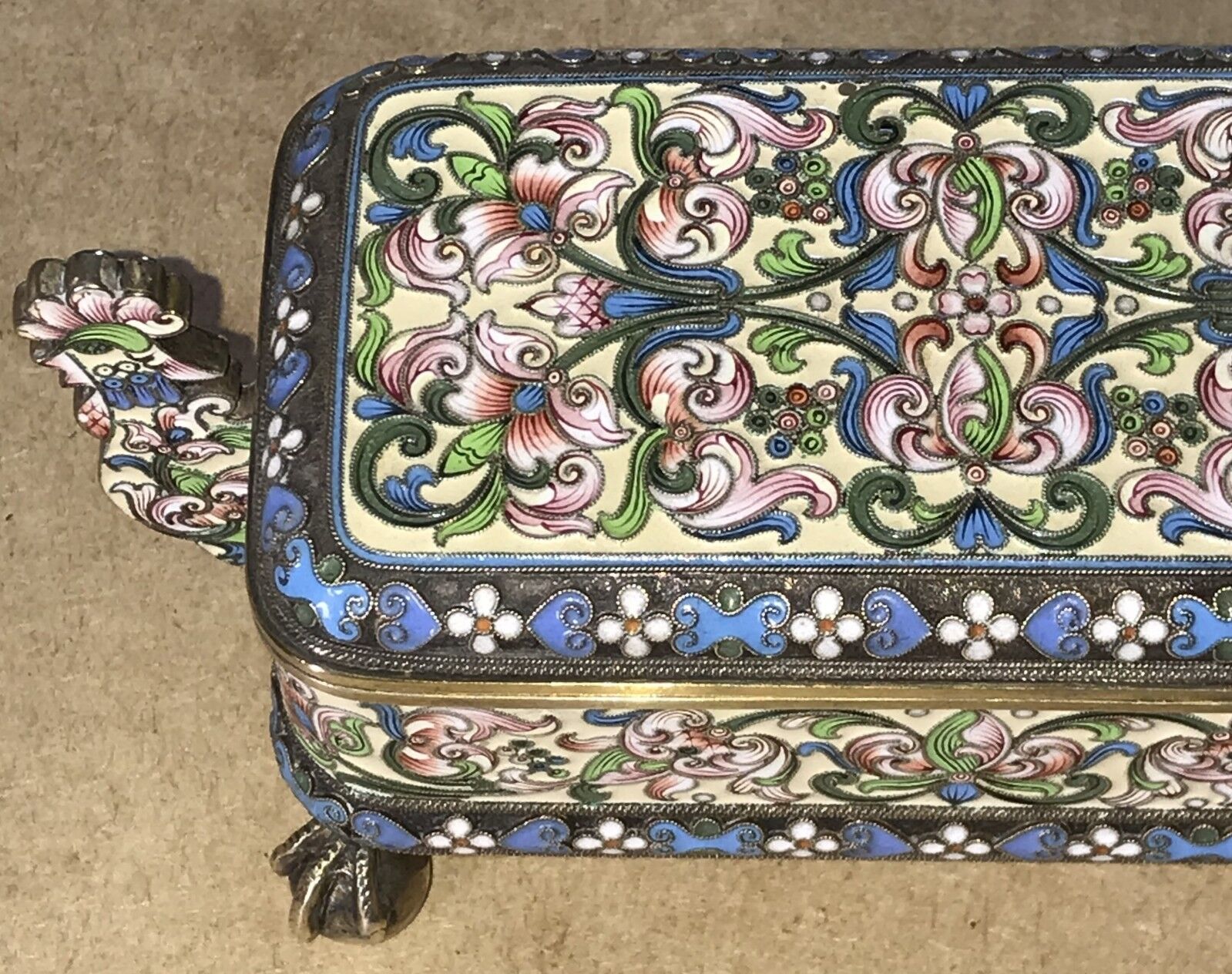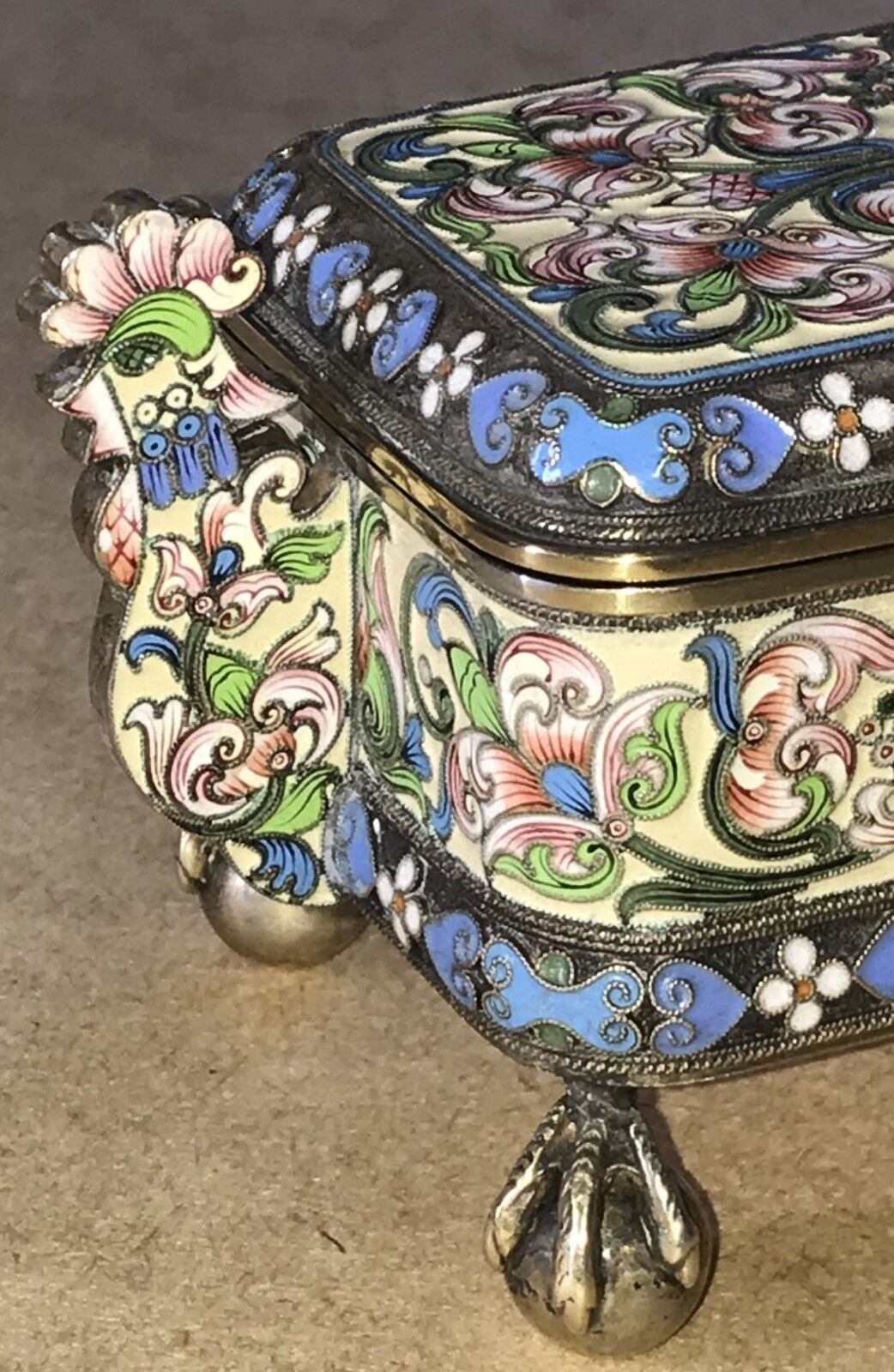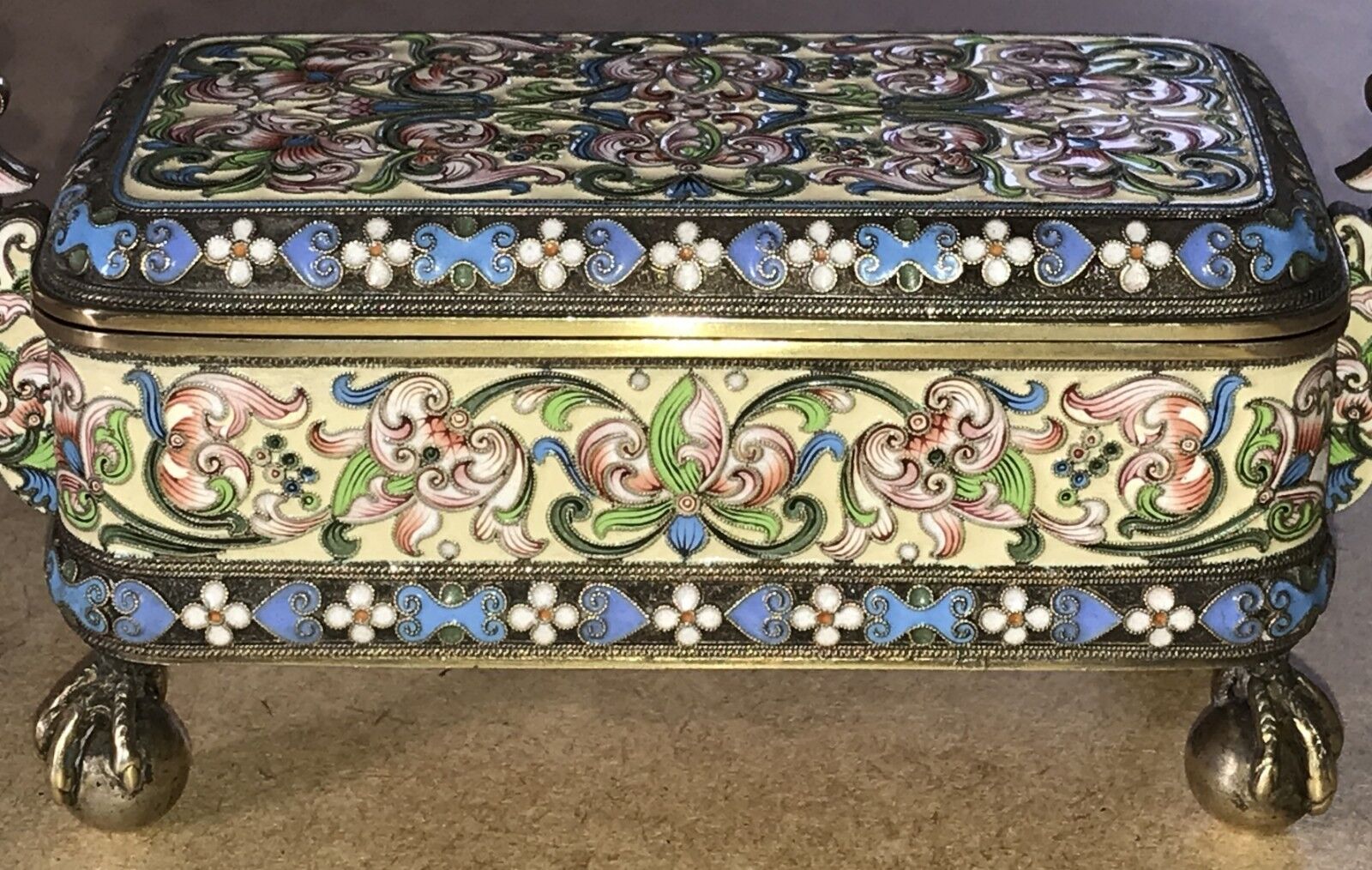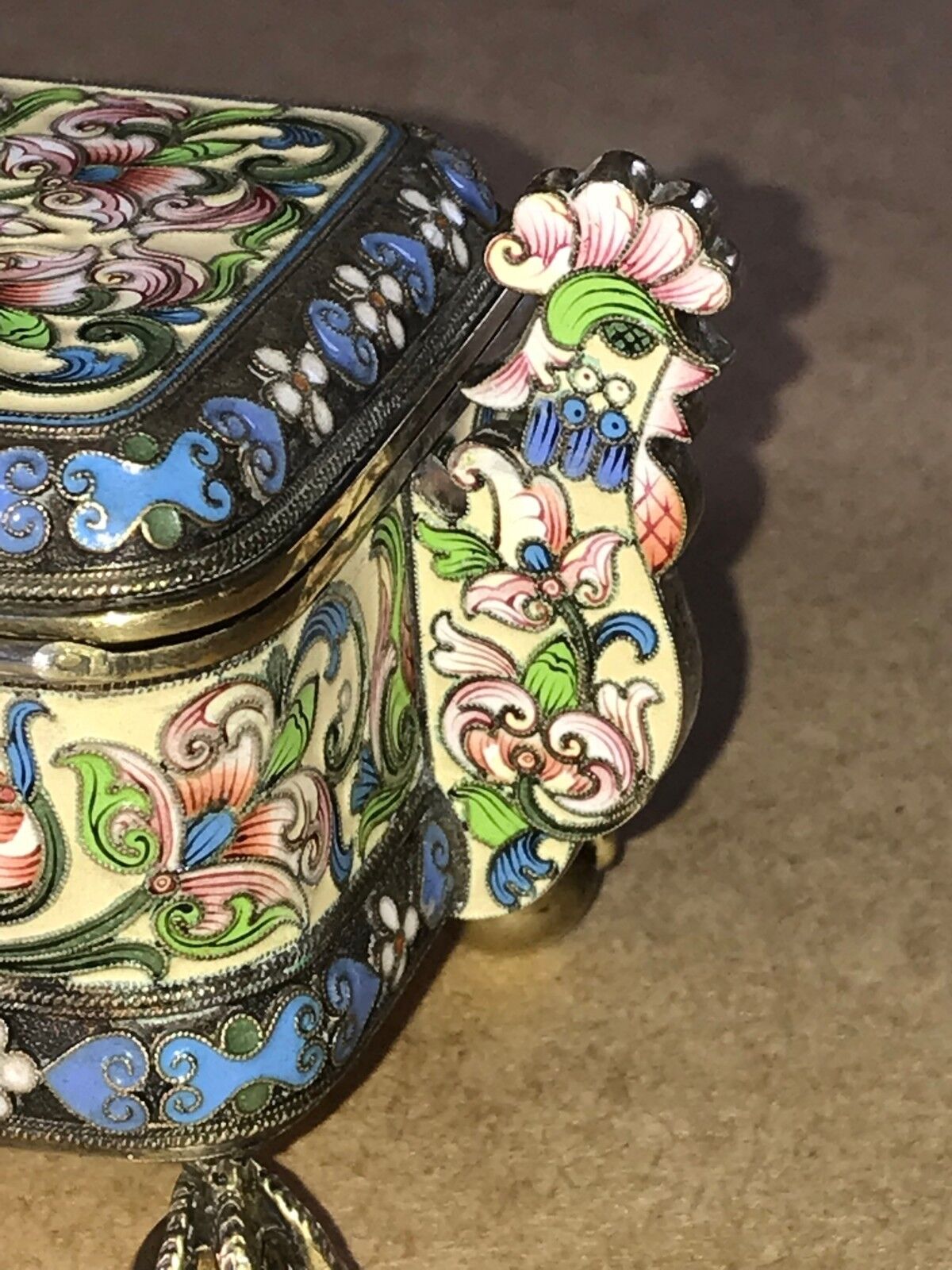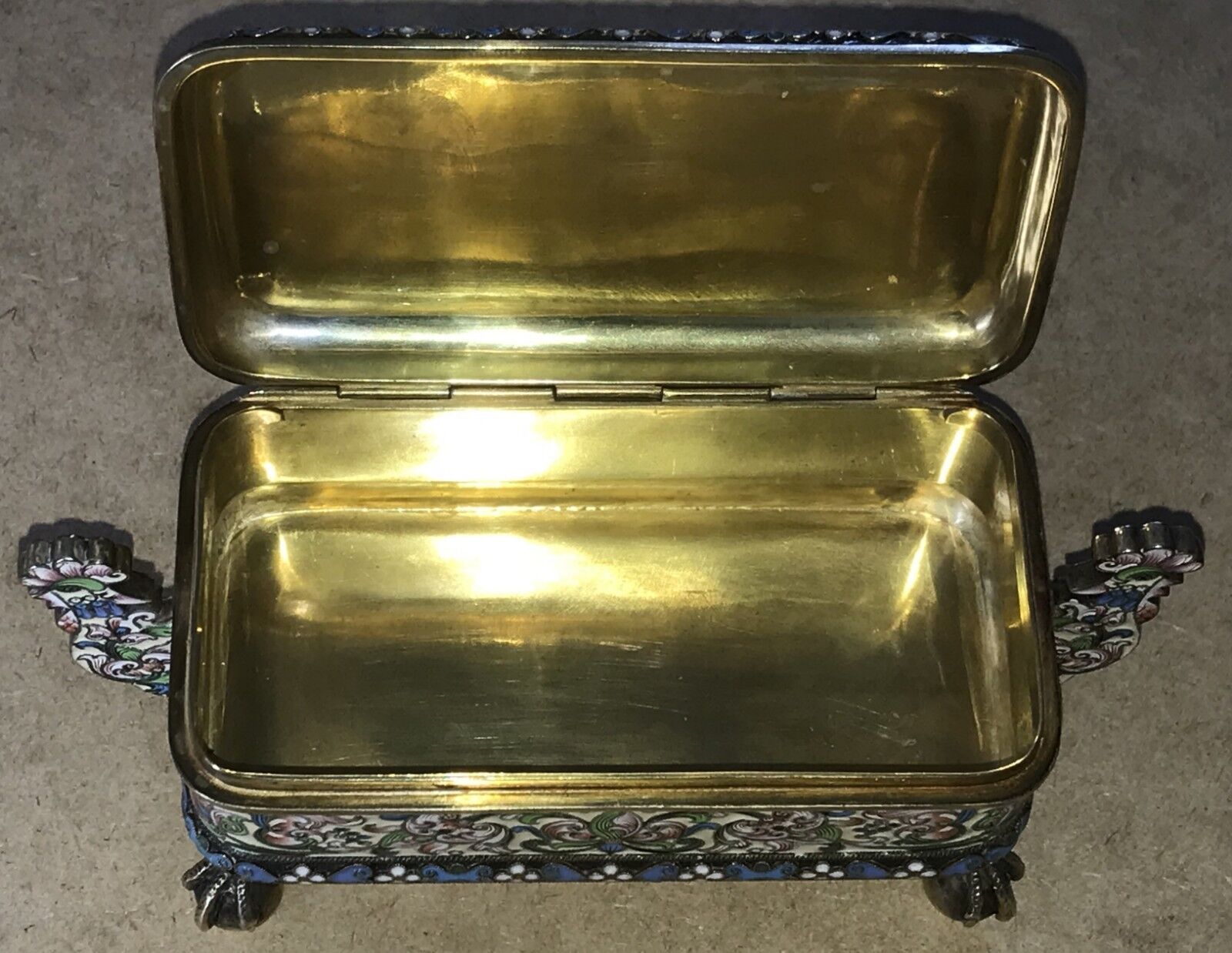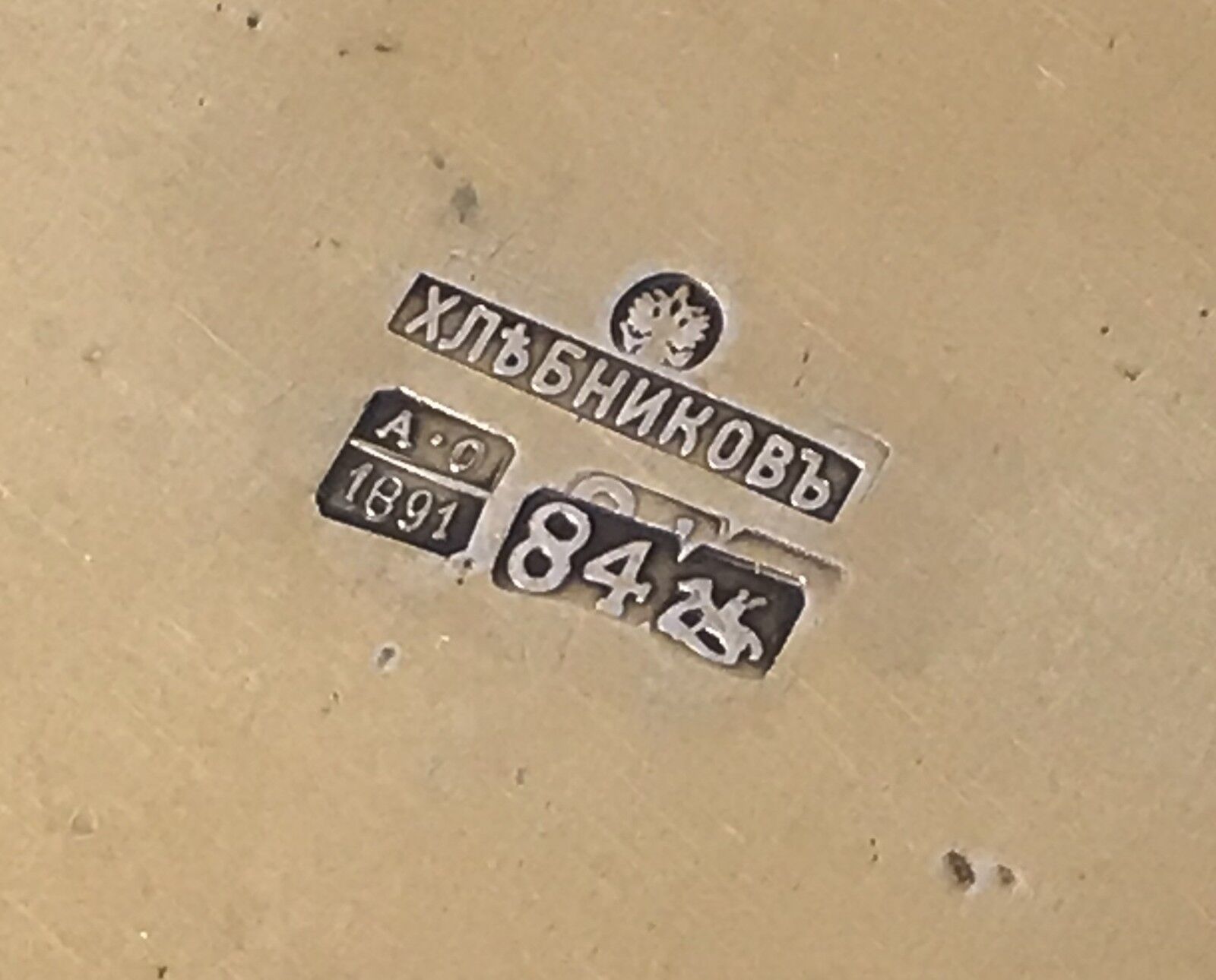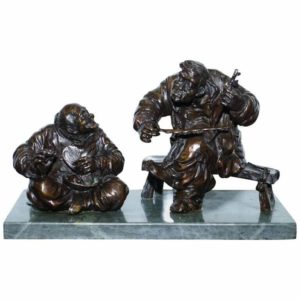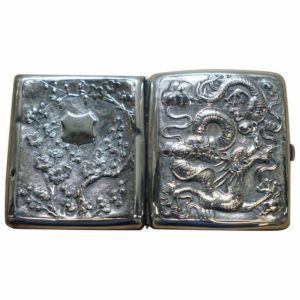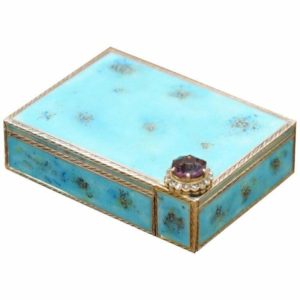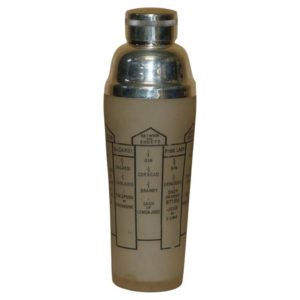Select Category
- All Tables
- Bedroom
- Bookcase
- Campaign Furniture
- Chesterfield Seating
- Cupboards
- Decorative Pieces
- Designer Brand Furniture
- Desks
- Dining Room
- Dining Tables
- Drawers
- Everything Else!
- Fine Furniture
- Fully Restored
- Gillows of Lancaster & London
- Howard & Son’s
- Jewellery & Watches
- Lighting
- Mirrors & Pictures
- Other
- Precious Metals
- Seating
- Sideboards
- Statues Sculptures & Art
RUSSIAN SILVER PAVEL OVCHINNIKOV & IVAN KHLEDNIKOV GILT CLOISONNE ENAMEL CASKET
£7,500.00
1 in stock
Payment options accepted

Description
Royal House Antiques
Royal House Antiques is delighted to offer for sale this stunning and very rare full-sized Imperial Russian 1891 Cloisonné Enamel casket box made from solid silver with gold gilding by the highly coveted Pavel Ovchinnikov, whilst he worked with Ivan Khlebnikov complete with the Romanov Eagle silver stamp for the last Czar and Tsarina of Russia.
Attached you can see a screen shot of some lots due for sale on the 26th November at Christie’s, I for one will be very excited to see the end results.
For those die hard Russian silver collectors out there this piece is just about as rare and important as they come, it confused me to begin with because it’s clearly made by Pavel Ovchinnikov, his other works of this kind are known and easily found with a little internet research, however it is stamped for Ivan Khlebnikov, after some hunting I found the following from “Museum collection” which is the name of a very prestigious museum in Moscow, you can read the full details below and the link is here https://mus-col.com/en/the-authors/10374/
The import extract is as follows “The growing fame helped the factory to receive the honorary orders. Together with the firm “Nicols and Plinke”, as well as with jewelers Pavel Akimovich Ovchinnikov (1830 – 1888) and Ivan Ekimovich Morozov (1825-1885) he was involved in the renovation of the Palace silver dinner sets. ”
The two silversmiths were working at the same time, in the same pallet of materials and on the same projects, this link inexplicably solves the mystery of how two of the three greatest silversmiths in Russia (Faberge being the third of course) came to collaboration.
The casket itself is an exceptionally rare find, I’ve only ever seen one other of this type come up for auction, it was just over 10 years ago in Christies, it was half the size, you can see on 1stdibs for the current market value of Ovchinnikov pieces, they are around the £15-£20,000 for small objects and £20-£40,000 for medium to large objects like this.
The piece is solid silver with gold gilding and cloisonné polychrome enamel, it’s detailed with scrolls and stylised flowers on stippled grounds within geometric borders, the two handles formed as cockerels and its finished with clawed ball feet.
The box is fully and clearly hallmarked A.O 1891, 84 with a rearing horse, then Khlebnikov in Russian Cyrillic below the Imperial warrant which as mentioned was awarded to Khlebnikov by the then Czar Nicholas II (18 May 1868 – 17th July 1918) and his wike the Tsarina Alexandra Feodorovna (6 June 1872-17th July 1918)
Condition wise the piece to my eyes and hands looks amazing, the finish around one of the claw feet at the top looks slightly different to the others so it may have possibly been repaired at some point, otherwise its museum quality.
Dimensions
Height 6cm
Width 12.5cm
depth 6.5cm
Please note all measurements are taken at the widest point, if you would like any additional or specific measurements please ask.
Pavel Ovchinnikov:
Appointed official purveyor to Tsar Alexander III (1865), King Victor Emmanuel II of Italy (1873), Grand Duke Mikhail Nikolaevich (1878) and King Christian IX of Denmark (1888). Awarded the Légion d’honneur (1867) and the Order of the Iron Crown (1873). Founded a school for 130 goldsmiths and silversmiths (1871). Opened a factory and shops in St Petersburg at 35 Bolshaya Morskaya Street (1873) and the former premises of Sazikov at 29 Bolshaya Morskaya Street (1900). Member of the Moscow City Duma (1876–88). Died and buried at Kalitniki (Moneybags) Cemetery in Moscow (1888), where his work was continued by his sons Mikhail, Alexander, Pavel and Nikolai (1888–1917).
Contributed to exhibitions (from 1865). Contributed to the Pan-Russian Manufacturing Exhibition in Moscow (1865, gold medal), Exposition Universelle in Paris (1867), Weltausstellung in Vienna (1873), Pan-Russian Exhibition of Art and Industry in Moscow (1882, silver medal), Exposition Universelle in Paris (1900), Princess Dagmar – Empress Marie Feodorovna at Christiansborg Palace in Copenhagen (1997), Golden Treasure Trove of the Russian Museum at the Russian Museum in St Petersburg (1998), Treasures of the Moscow Kremlin at the Alexander Radischev Museum of Art in Saratov (2005) and Samara Regional Museum of Art in Samara (2005–06), Empress Maria Fedorovna: A Life and Fate at the Federal Archives Exhibition Hall in Moscow (2006), Russian Silver of the 18th–20th Centuries from the Collection of the Moscow Kremlin Museums at the Samara Regional Museum of Art in Samara (2007–08), Enamels of the World 1700–2000 from the Khalili Collections at the Hermitage Museum in St Petersburg (2009–10), Russian Silver (18th to Early 20th Centuries) at the Ivan Shemanovsky Museum and Exhibition Complex of the Yamalo-Nenets Autonomous District in Salekhard (2010–11), Golden Age of Russian Jewellery Art at the Vladimir-Suzdal Museum Complex of History, Architecture and Art in Vladimir (2010–11), Russian Jewelry – Traditions and Modern Day at the Estet Jewelry House in Moscow (2011), Splendour and Glory: Art of the Russian Orthodox Church at the Hermitage Amsterdam in Amsterdam (2011), Gold: Metal of Gods and King of Metals at the History Museum in Moscow (2012), Fabergén aika at the Museum Centre Vapriikki in Tampere (2006), Il gioielliere degli ultimi Zar at La Venaria Reale in Turin (2012), World of Fabergé at the Shanghai Museum in Shanghai (2012–13), Fabergé: Legacy of Imperial Russia at the Hong Kong Heritage Museum in Hong Kong (2013) and Fabergé: A Brilliant Vision at the Houston Museum of Natural Science in Houston (2013).
Khlebnikov factory The history
The founder of the dynasty, Ivan Petrovich Khlebnikov was born in 1819 in Moscow, in the burgher family in Luzhniki region. Practically nothing was known about his works until he established a private firm. It might be possible that the son followed up the father’s business. Piotr Khlebnikov had been enlisted in merchantry since 1832 and was the owner of the trading and manufacturing jewellery establishment. Very little is known about the history of the firm.
According to some researchers, Ivan Petrovich was working in St. Petersburg until 1867. He founded the manufacturing firm in Moscow in 1870. He wrote, “being engaged in the silver and gold articles trading for about forty years, I opened a manufactory of my own…» It is possible that in the 1830s, I. Khlebnikov already owned a shop, but he opened the factory later, at the turn of 60-70s of the 19th century. One hundred people were working at the factory and the turnover of production was 56 thousand rubles in 1871. Since that time, the firm began to grow. Several shops were opened: a store at the Kuznetski Bridge in the house of Solodovnikov, a store on Ilijnskaya street in the house of Novgorod courtyard in the silver row. New shops were opened in other cities: in Saint Petersburg in Nevsky Prospekt and in the main line of the Nizhny Novgorod fair.
The factory was well equipped with the latest technique for all types of works, produced articles in all major styles of the second half of the 19th – early 20th century. The Russian and Modern styles were very popular, as well as various historic styles: the Neo-Baroque, Neo-Rococo, and Neo-classicism styles.
In addition to the main factory with special space for painting and sculpture, about 300 workers were employed; there were special workshops for stone cutting, metal processing, etc. Khlebnikov matured as a jeweller in the period of his close collaboration with the Petersburg firm Gasse.
He regularly participated in various exhibitions. For the first time Ivan Petrovich exhibited his works together with P. A. Ovchinnikov at the Moscow Polytechnic exhibition in 1872. His works were awarded with two large gold medals.
The growing fame helped the factory to receive the honorary orders. Together with the firm “Nicols and Plinke”, as well as with jewelers Pavel Akimovich Ovchinnikov (1830 – 1888) and Ivan Ekimovich Morozov (1825-1885) he was involved in the renovation of the Palace silver dinner sets.
Khlebnikov factory produced for Anichkov and Gatchina palaces 160 new items of The Golden Set made by artists G. F. Eckart and J. G. Blom in 1759-1784; The missing items were made for other sets of these same palaces; The Dessert set with the monogram of Catherine II, donated by Prince G. Potemkin was renovated; The Orlovsky dinner set was manufactured in 1772-1776; The Fourth Camping set was made. It was submitted to the Imperial Palace in 1797 as a gift from merchant Glazunov; Coffee pots, teapots, sugar bowls, milk jugs, teaspoons and spoons for salt, quadrangular flat serving dishes for several dinner sets from the Winter Palace on the old models were manufactured according to the old models.
From the first years of its existence, the factory gained the right to be ranked as the Supplier of the Imperial family due to high quality of the produced silver and gold articles. Khlebnikov supplied with his production Grand Dukes since 1869. He was titled the supplier of the court of the Grand Duke Konstantin Nikolayevich in 1869, continually had been receiving orders for the wardrobe of Her Majesty the Empress Maria Alexandrovna since 1873. This fact was an honorary distinction and evidenced about his good reputation among the customers. Khlebnikov’s jewellery came to fashion. Having achieved recognition, Ivan dreamed of the most honorable title “The Supplier of the Imperial Court”. He wrote in 1875, “the right to be called the Supplier of the court… will serve me and my heirs, the successors of my business – the most invaluable encouragement to continue honest labor and precious estimation of my firm”. Finally, in 1879 he received the long-awaited title of ‘The Supplier of Russian Imperial Court” and the right to depict the national armorial bearings on the factory sign.
The firm of Khlebnikov was awarded with the title of “The Supplier of the Danish, Dutch and Serbian Kings’ Courts”, as well as “THe SUpplier of Montenegrian Prince Court”. Ivan Petrovich died in 1881, at the age of 62, was buried in the Spaso-Andronikov monastery. His sons inherited his business: Michael, Alex, Nicholas and Vladimir. 300 artisans were working at their factory “Partnership I. P. Khlebnikov, Sons & Co” in 1882. There were the goldsmiths, coppersmiths, chasers, haberdashers, enamellers and filigree artists. They represented all sectors of goldsmith. There were specialized workshops, the number of workers in which amounted 1,000 people. The fame of the factory and its authority after the death of Ivan Petrovich did not diminished. Together with the best Moscow jewellers-manufacturers, the firm participated in the decoration of the temple of Christ the Savior. The Khlebnikov’s family created nearly 50 religious articles according to their sketches and drawings: ostensories, chalices, Holy-water bowls, and jugs for Holy water, incense burners, serving dishes, and icon-lamps.
Nevertheless, the mass-market production mainly provided the financial wellbeing of the company. Large quantity of medium-priced silver objects, dinnerware, cutlery and jewellery was produced. A trading-industrial enterprise under the name Partnership for production of silver, gold and jewellery “I. P. Khlebnikov, Sons and Co” was established on the basis of the company. It expanded and assimilated well-known jewellery shops and factories owned by Sazikov, both in Moscow and St. Petersburg. The catalog of M. M. Postnikov “Gold and Silver Manufacturing of the 15th-20th centuries” narrated that by 1897 the factory of brothers Khlebnikov possessed two steam engines and one steam boiler. They manufactured production for the total amount of 172 372 rubles.
The achievements of the firm “I. P. Khlebnikov, Sons & Co” were distinguished in the development of Russian jewellery”. Ivan Petrovich was awarded with a bronze medal on the Anninskaya ribbon and five Golden medals. His elder son, Mikhail Ivanovich was awarded with the order of Stanislaus of the third degree in 1881 and was ranked as an honorary citizen of St. Petersburg in 1883. Other brothers were ranked as honorable citizens in 1887.
The factory was closed on June 24, 1917. Under the will of one of the Khlebnikov’s brothers, the shares of the company were donated to Moscow County Zemstvo. The main enterprise was reorganized in the Moscow platinum factory in 1918. It mainly produced all kinds of items for the electrochemical industry and research laboratories, and in addition, a small amount of silver jewellery, mainly utensils, cutlery and glass holders, which were marked with the seal “platinum-device”.
The memory remained from the firm P. Khlebnikov, Sons and Co”, jewellery treasures and the facade of the factory building (it was built on the crossing of Ryumin lane and Upper Radischevskaya street).
Any questions please feel free to ask before you bid.
ABOUT US
Royal House Antiques is a privately owned family ran business founded in Wimbledon SW19 and now based in Pulborough RH20. We specialise in finding, restoring very fine luxury antique leather seating, along with every single other type of antique ranging from the 16th century to the 20th century. We also stock a number of designer brands such as Fritz Hansen, Ralph Lauren, Cavalli, Charles & Ray Eames, Vitra, David Linley, Rolex, Tiffany, Jager Le Coulter and so on
PAYMENTS
We accept payment via Bitcoin, Bitcoin cash, Ethereum, Bacs, Chaps, PayPal or Card, we would kindly ask that all items are paid for within 48 hours and collected within 7 working days, we can hold all paid items for 14 days free of charge, there after a £20 a week storage fee will apply. We have long term storage which is very economically priced, we are happy to hold stock for as long as needed providing it is arranged prior to the purchase
If sold items aren’t collected within three months and no arrangements have been made for long term storage you will forfeit the item and payment
CONDITION
Please view the very detailed pictures as they form part of the description pertaining to the condition. Please also ask any questions before you bid and not after, all of our items are sold as seen and as listed
Royal House Antiques cannot be held liable for any independent assumptions made regarding the items we sell, if you are unsure on any point, please feel free to ask for clarity
Please note vintage period and original items such as leather seating will always have natural patina in the form of creasing and wear, we recommend annual waxing to ensure no moisture is lost, also hand dyed leather is not recommended to sit in direct sunlight for prolonged periods of time as it will dry out and fade
IMPORT DUTY
Most countries charge some kind of import duty however almost all of our items won’t incur any charges as the items are exempt from tax due to the age and materials used
For European deliveries the price you will be quoted will include all clearance documentation and any customs charges so there won’t be any additional fees
For international deliveries such as the United States there can be some import duty to pay and or a clearance fee, I would estimate that 99% of all deliveries clear customs without being stopped for either
All duties are the responsibility of the purchaser who is the importer, they can’t be covered by the seller or shipping agent or factored in with additional retrospective discounts
RETURNS
Royal House Antiques offers a no quibble return policy if the item is not as described, if there are any issues with the piece you will be refunded in full once the item has been returned and inspected within 14 days, alternatively if there is a small issue, we can discuss finding a mutual resolution that makes all parties happy
We don’t offer a sale on approval service which means you can purchase the item, have it delivered and if you simply don’t like it, return it, this comes under change of mind or doesn’t fit. There is a lot of time, money and work involved in transporting goods around the world, the costs incurred can be vast so my advice would be if you are unsure on a piece please ask as many questions as you like to make sure you understand everything before you buy, if you are still unsure then please either arrange a viewing in person or if that’s not possible then don’t buy from an online retailer, perhaps look for a local gallery instead
Additional information
| Featured Refinements | |
|---|---|
| Product | |
| Style | |
| Age | |
| Material | |
| Pattern | |
| Antique | |
| Composition | |
| Brand |
Related products
About Us
Royal House Antiques is a privately-owned family ran company founded in Wimbledon in 2012 by husband and wife James and Iris Thorpe

Usefull information
Contact Us
- Tel: 07850890032
- Email: james-thorpe-2010@hotmail.co.uk
Copyright 2024 Wimbelon-Furniture

